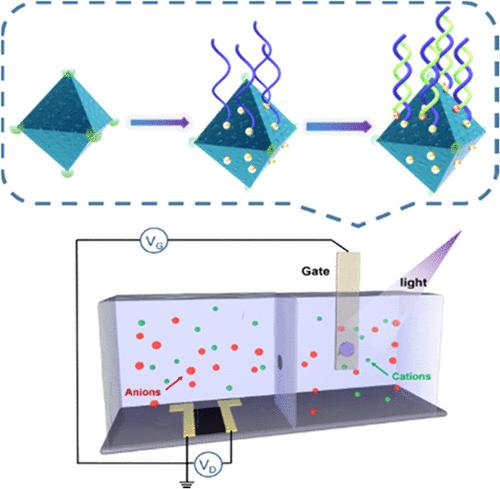当前位置:
X-MOL 学术
›
Anal. Chem.
›
论文详情
Our official English website, www.x-mol.net, welcomes your
feedback! (Note: you will need to create a separate account there.)
Duplex-Specific Nuclease-Enabled Target Recycling on Semiconducting Metal–Organic Framework Heterojunctions for Energy-Transfer-Based Organic Photoelectrochemical Transistor miRNA Biosensing
Analytical Chemistry ( IF 6.7 ) Pub Date : 2022-10-31 , DOI: 10.1021/acs.analchem.2c03859 Ge Gao 1, 2 , Jia-Hao Chen 1 , Cheng-Jun Li 1 , Cheng-Shuang Wang 1 , Jin Hu 1 , Hong Zhou 3 , Peng Lin 4 , Qin Xu 2 , Wei-Wei Zhao 1
Analytical Chemistry ( IF 6.7 ) Pub Date : 2022-10-31 , DOI: 10.1021/acs.analchem.2c03859 Ge Gao 1, 2 , Jia-Hao Chen 1 , Cheng-Jun Li 1 , Cheng-Shuang Wang 1 , Jin Hu 1 , Hong Zhou 3 , Peng Lin 4 , Qin Xu 2 , Wei-Wei Zhao 1
Affiliation

|
Semiconductor metal–organic frameworks (MOFs) and heterojunctions have gained increasing attention in many fields, yet their full potential remains largely unexplored. Advanced optobioelectronics are envisioned to create more opportunities for innovative biomedical applications. This study reports a UiO-66-NH2 (U6N)/CdS quantum dots (QDs)-gated organic photoelectrochemical transistor (OPECT) and its application toward energy-transfer-based sensitive microRNA-166a (miRNA-166a) detection assisted by duplex-specific nuclease (DSN)-enabled target recycling. Specifically, a U6N/CdS QDs photoanode was fabricated and shown to be efficiently gating a poly(3,4-ethylenedioxythiophene) doped with poly(styrene sulfonate) (PEDOT/PSS) channel, while the DSN-enabled release of Au-reporters and hybridization upon the U6N/CdS QDs photoanode could significantly inhibit the photoanode response via an energy transfer process and thus modulate the device response, permitting novel dual-amplified optobioelectronic miRNA-166a detection with a low detection limit of 1.0 fM. This work not only features the DSN-amplified miRNA detection via an OPECT route but also unveils the potential of semiconductor MOF heterojunctions for futuristic optobioelectronics.
中文翻译:

用于基于能量转移的有机光电化学晶体管 miRNA 生物传感的半导体金属-有机框架异质结上双链体特异性核酸酶使能靶点回收
半导体金属有机框架 (MOF) 和异质结在许多领域受到越来越多的关注,但它们的全部潜力在很大程度上仍未得到开发。先进的光生物电子学有望为创新生物医学应用创造更多机会。本研究报道了一种 UiO-66-NH 2(U6N)/CdS 量子点 (QDs)-门控有机光电化学晶体管 (OPECT) 及其在基于双链特异性核酸酶 (DSN) 的目标回收辅助的基于能量转移的敏感 microRNA-166a (miRNA-166a) 检测中的应用. 具体来说,制造了一个 U6N/CdS QDs 光阳极,并证明它可以有效地门控掺杂有聚(苯乙烯磺酸盐)(PEDOT/PSS)通道的聚(3,4-亚乙基二氧噻吩),而 DSN 支持释放 Au 报告基因和在 U6N/CdS QDs 光电阳极上的杂交可以通过能量转移过程显着抑制光电阳极响应,从而调节设备响应,允许新型双放大光电 miRNA-166a 检测,检测限低至 1.0 fM。
更新日期:2022-10-31
中文翻译:

用于基于能量转移的有机光电化学晶体管 miRNA 生物传感的半导体金属-有机框架异质结上双链体特异性核酸酶使能靶点回收
半导体金属有机框架 (MOF) 和异质结在许多领域受到越来越多的关注,但它们的全部潜力在很大程度上仍未得到开发。先进的光生物电子学有望为创新生物医学应用创造更多机会。本研究报道了一种 UiO-66-NH 2(U6N)/CdS 量子点 (QDs)-门控有机光电化学晶体管 (OPECT) 及其在基于双链特异性核酸酶 (DSN) 的目标回收辅助的基于能量转移的敏感 microRNA-166a (miRNA-166a) 检测中的应用. 具体来说,制造了一个 U6N/CdS QDs 光阳极,并证明它可以有效地门控掺杂有聚(苯乙烯磺酸盐)(PEDOT/PSS)通道的聚(3,4-亚乙基二氧噻吩),而 DSN 支持释放 Au 报告基因和在 U6N/CdS QDs 光电阳极上的杂交可以通过能量转移过程显着抑制光电阳极响应,从而调节设备响应,允许新型双放大光电 miRNA-166a 检测,检测限低至 1.0 fM。


















































 京公网安备 11010802027423号
京公网安备 11010802027423号